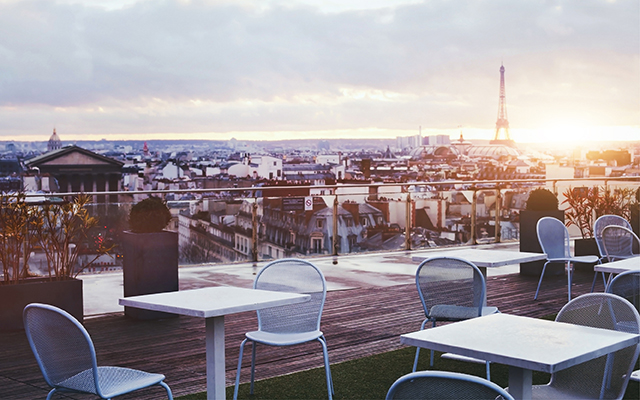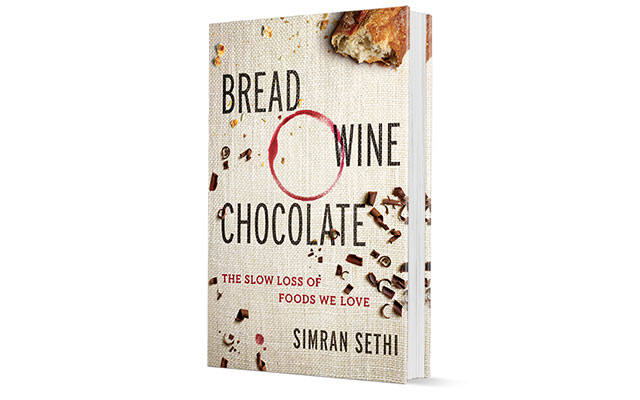Alice Waters might be known as a crusader for healthier food, but the legendary activist and restaurateur never had a grand plan to revolutionize the American diet.
Growing up eating casseroles and rhubarb from her family’s victory garden in suburban New Jersey, Waters had simpler tastes and aspirations. “When I was little, I always wanted to go to the Museum of Natural History and eat at the Automat for my birthday,” the 74-year-old creator of Berkeley’s iconic Chez Panisse restaurant writes in her memoir, Coming to My Senses: The Making of a Counterculture Cook. “[The Automat] was the first restaurant I remember going to; I must have been 6 or 7.”
Dining out was reserved for special occasions in her family, so standing amid the Automat’s shiny stainless-steel doors with windows displaying foods was a magical experience. “I loved being given my own money and the fact that I could choose exactly what I wanted,” she recalls.
During college, Waters spent a year in Paris, where she cut classes, hitchhiked through the countryside, and dated locals. She also developed a taste for buckwheat crêpes, oysters, and rosé.
But it was the simplicity of a locally sourced meal she ate in Brittany that served as a blueprint for Chez Panisse, which would change America’s food culture forever.
Back in Berkeley, Waters hobnobbed with artists and radicals of the Free Speech Movement. This eclectic crew became Chez Panisse’s investors, employees, and customers.
Basing a menu on what was locally grown and in season led Waters to offer one fresh, homemade entrée each evening at Chez Panisse. This slow approach to food led to a delicious revolution in restaurants and kitchens across the United States.
“A lot of why Chez Panisse succeeded was because it didn’t feel like just another restaurant. We were a family — or at least an eccentric, tight-knit tribe,” notes Waters. “As James Beard said later, ‘It’s like you’re eating dinner in somebody’s home.’ I wanted it to feel like that.”
Waters’s book is a beautiful exploration of the importance of feeding all your senses. Here are a few of our favorite passages. —Heidi Wachter
Reclaiming Beauty
“Beauty” is a word that the fast-food culture has taken from us — we have no idea what it means anymore. They call things beautiful, and they aren’t. We’ve been made to feel that beauty is expensive — that you can’t afford it, that beautiful things are only for the people who make a lot of money.
But you can make your house beautiful no matter what. It can be about something as simple as putting colored glass bottles in the windowsill, like [my] Aunt Ina, or lighting candles. . . . Walking into a space that’s beautiful — whether it’s a room in your own home or somewhere out in the world — is a huge enticement. And when something is beautiful, everybody realizes it. It’s like walking into a grove of old-growth redwoods or witnessing an extraordinary sunset — there isn’t one person who isn’t dumbfounded. It doesn’t matter what you’re thinking about or who you are. You see that kind of beauty, and you’re awestruck.
It’s about everything in life: What do you want to look at while you’re washing the dishes? Can you make your own lampshade rather than buy it? What sort of rose can you plant in your garden? What herbs can you plant on your fire escape? What sort of pan do you have sitting on your stove? What kind of handle does it have?
Cheese, Please!
I’ve always loved cheese. I love it. I love that it has so many possibilities, culinarily — from the little cheese in a taco to the whole myriad of goat cheeses and French cheeses. And I think of grilled cheese sandwiches as one of the great comfort foods.
These days I make them with a Cantal, a mountain cheese from France that’s a little like a Swiss — I like my cheese to be a bit tangy. I usually choose some good whole wheat or levain bread from Acme Bread Company. I slice the cheese and put it inside the bread, put some olive oil in a cast-iron pan — not too much! — drizzle oil on top of the sandwich, and then weight it down with another cast-iron pan. When it gets really brown, I turn it over, and when the cheese starts to bubble out the sides, I take it out. Then I rub both sides with a half clove of garlic and serve it with a dill pickle or some sauerkraut (good homemade sauerkraut, not the kraut out of a can that I never liked as a child!).
Or I’ll have a little undressed salad on the side — the melted cheese and the olive oil from the sandwich almost dress the lettuce. Sometimes in the summer I’ll put some hot peppers in the sandwich or serve it with a tomato salad.
Unwritten Instructions
Something can be lost in writing down a recipe. People can become so focused on measuring ingredients that they’re not tasting as they go along, and at the end of it, they don’t have the confidence to cook without a recipe.
I like great cookbook writers like Elizabeth David, Richard Olney, Diana Kennedy, and Madhur Jaffrey, who describe the raw materials in a beautiful way, encouraging you to go out to the farmers’ market and experience it all for yourself. That’s where the real learning happens.
The famous French chef Alain Ducasse says 85 percent of cooking is shopping; it may even be more than that; it might be 90 percent. But that’s not, of course, going to the supermarket — it’s going to the farmers’ market, or out into your backyard, finding what’s ripe and beautiful and alive and in season. This is my favorite recipe: “Go get some perfectly ripe figs in August, put them on a plate, and eat them.”
No, my favorite recipe is: “Go cut some mint from the garden, boil water, pour it over the mint. Wait. And then drink.” That’s my favorite recipe.
This originally appeared as “An Appetite for Change” in the November 2018 print issue of Experience Life.
Reprinted from Coming to My Senses: The Making of a Counterculture Cook. Copyright © 2017 by Alice Waters. Published by Clarkson Potter/Publishers, an imprint of Crown Publishing Group, a division of Penguin Random House LLC.




This Post Has 0 Comments